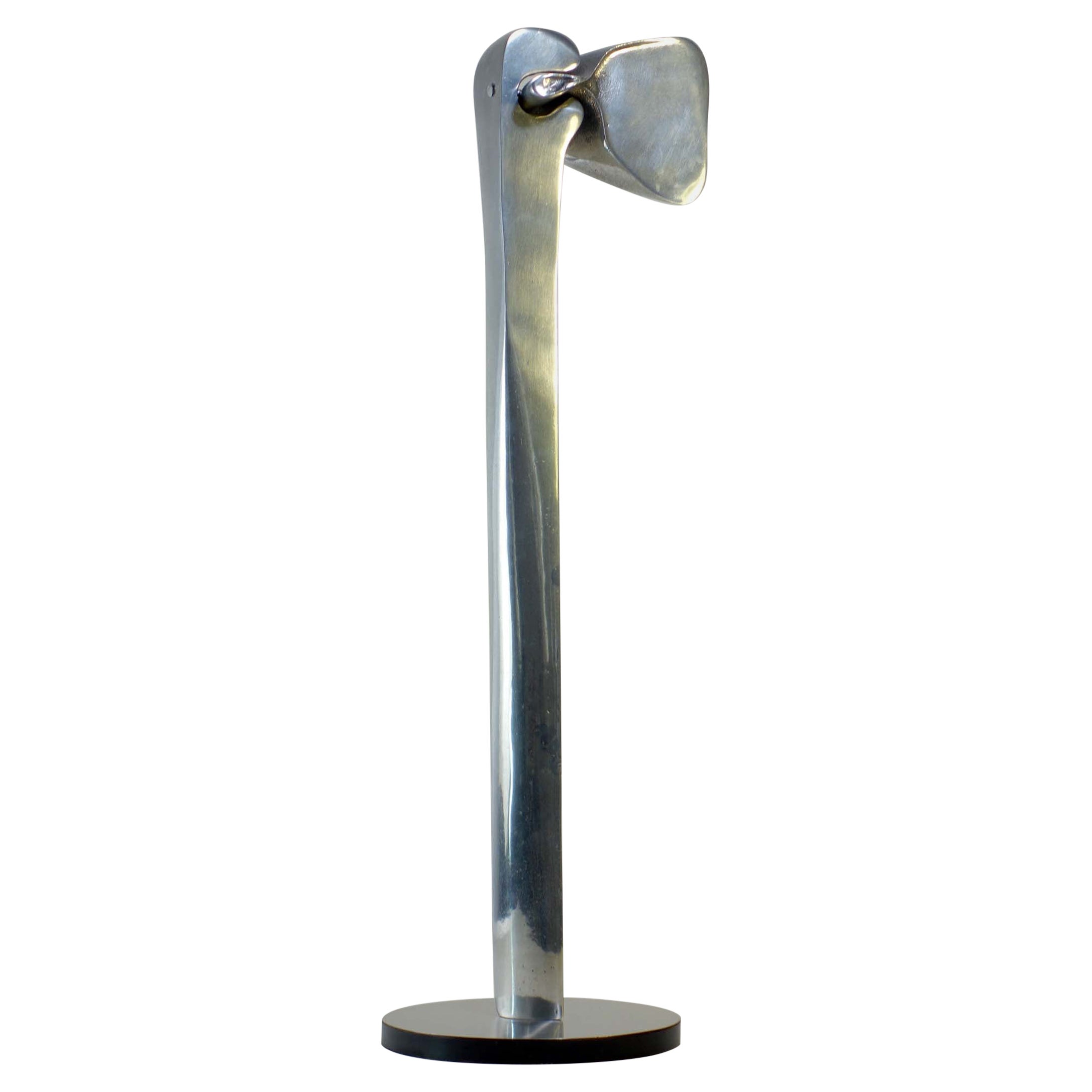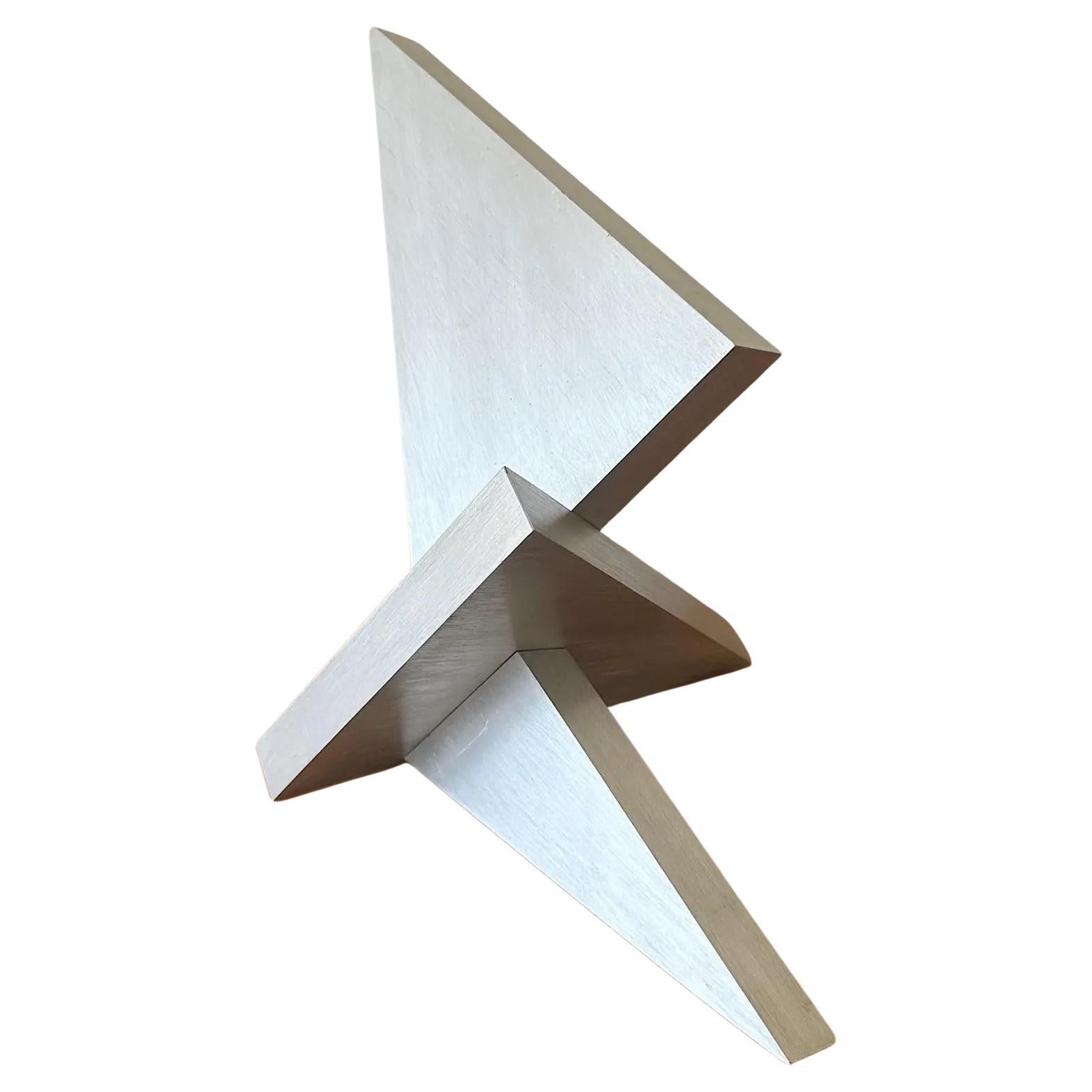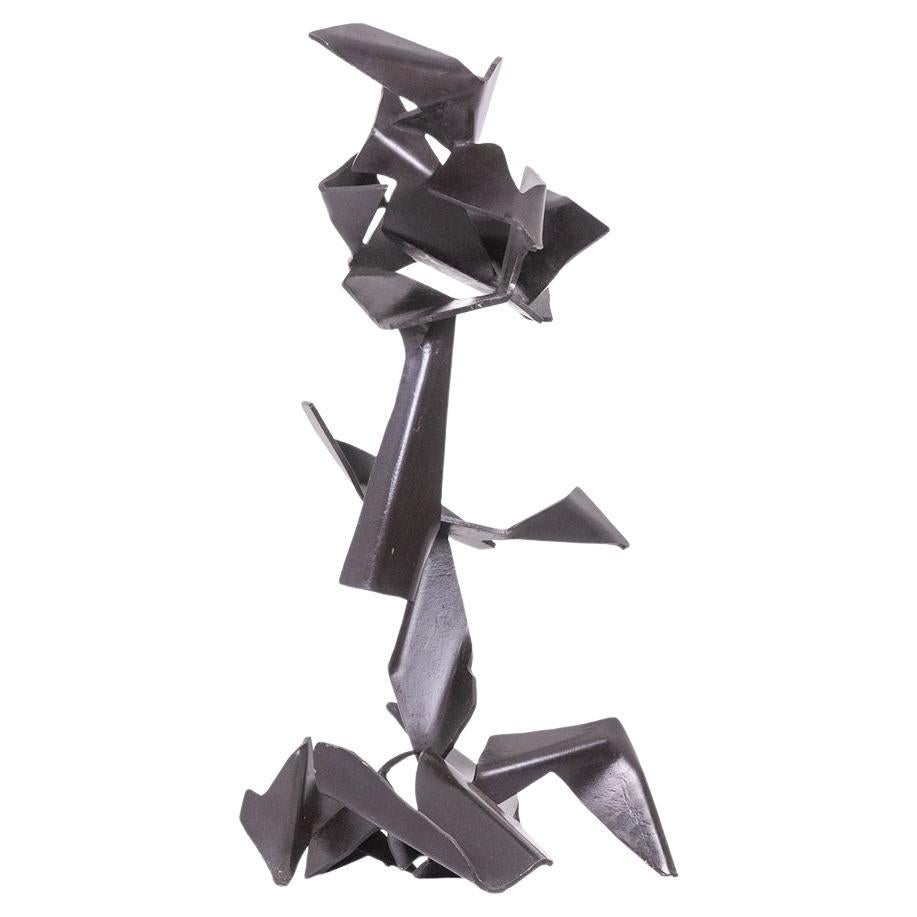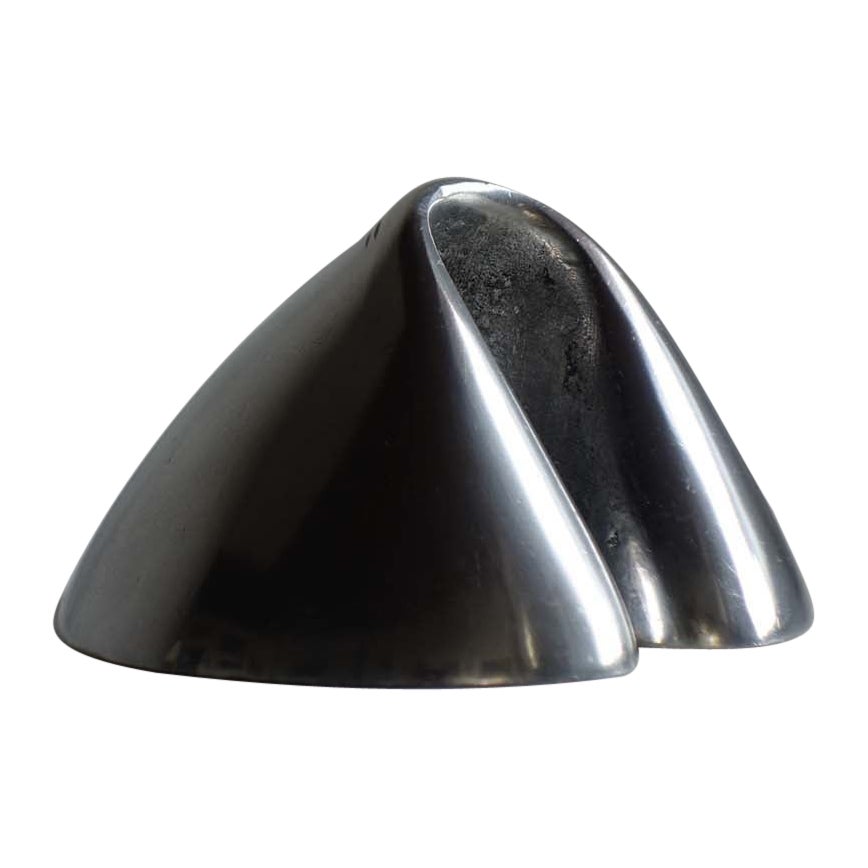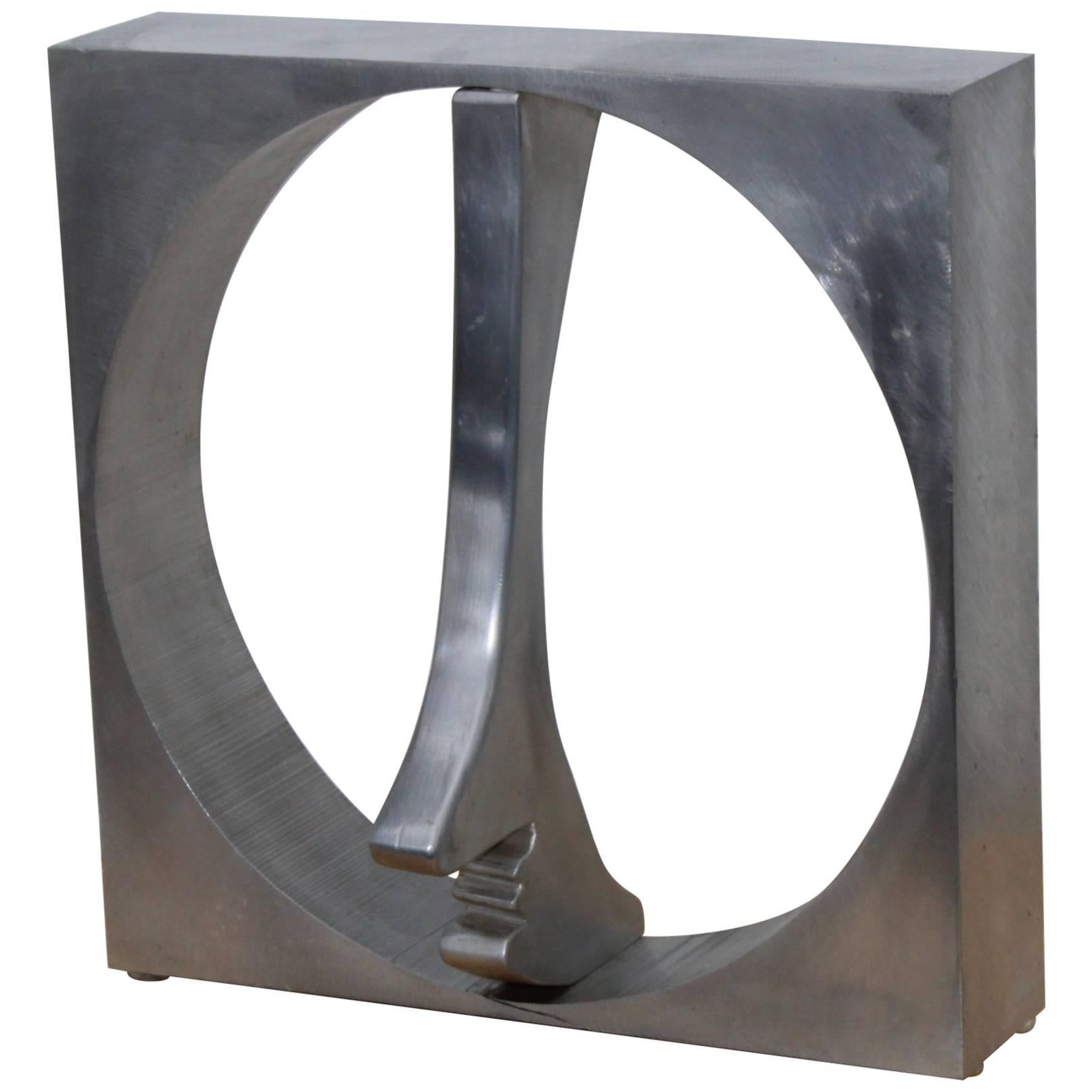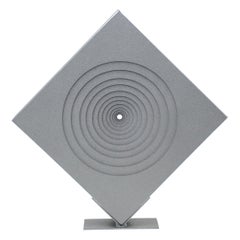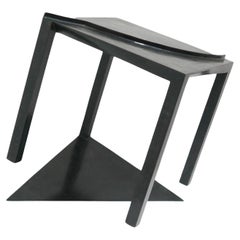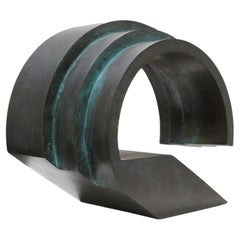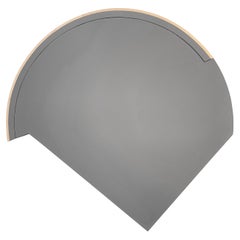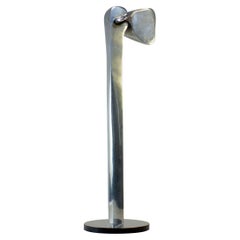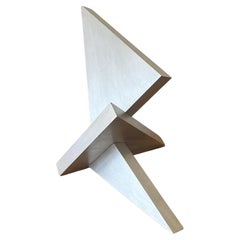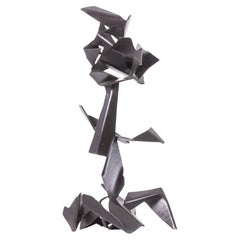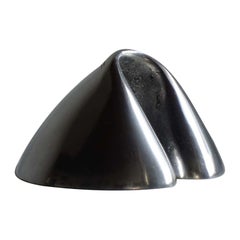Items Similar to Tony DeLap "Dr. Q", 1967 Stainless Steel Sculpture
Want more images or videos?
Request additional images or videos from the seller
1 of 5
Tony DeLap "Dr. Q", 1967 Stainless Steel Sculpture
$85,000
£64,897.12
€74,988.04
CA$119,323.91
A$132,998.93
CHF 69,779.97
MX$1,624,133.76
NOK 883,566.20
SEK 835,104.46
DKK 559,668.44
About the Item
Dr. Q, 1967
Brushed Stainless Steel, Lacquer
12.75 x 12.75 x 2.5"
Born in Oakland in 1927, Tony studied at the California College of Arts and Crafts, Academy of Art San Francisco, and Claremont Graduate School. After several teaching positions in the Bay Area, John Coplans invited Tony to join the 1965 founding faculty of UC Irvine, where he taught in the Art Department until 1991. He served as the project consultant for “Best Kept Secret, UCI and the Development of Contemporary Art in Southern California, 1964-1971” for the Getty’s “Pacific Standard Time: Art In LA 1945-1980,” at the Laguna Art Museum in 2011. With Chris Burden, James Turrell, Bruce Nauman, and Marcia Hafif among his students during his tenure at UCI, his contributions to art since the ‘60s are undeniable. His influence on his students, however, should not overcast his contributions as an artist in his own right.
Associated with Southern California’s so-called Finish Fetish movement of the 1960s, Tony stayed true to Minimalism decades after the height of its popularity and defined the work of art as “a thing in itself.” Eschewing outside references, Tony stripped art to its essence: materials and form. These materials include wood, metal, and plastics, formed into geometric shapes and multipart structures filled with illusions of depth and formal relationships that are both playful and rigorous. The LA Times’ Christopher Knight describes Tony’s work as “impossible objects,” not
only because they graft the otherwise distinct forms of painting and sculpture, but also because of Tony’s peculiar geometries. Tony’s hybrid painting-sculptures are truly confounding to experience. These “irregular geometries” cast dynamic shadows that invite viewers to experience the work from all angles, even the most oblique.
As a pioneer of Abstraction, Minimalism and Op Art on the West Coast, Tony was included in the landmark exhibitions The Responsive Eye (1965: MoMA, NY), Primary Structures (1966: Jewish Museum, NY), and American Sculpture of the Sixties (1967: LACMA, CA)—exhibitions that were crucial to the development and definition of Minimalism. Over the course of his 60-year career, he had a number of retrospectives: the Orange County Museum of Art in 2000; the San Jose Museum of Art in 2001; the Oceanside Museum of Art in 2013; and, most recently, the Laguna Art Museum’s major retrospective curated by Peter Frank in 2018.
Major museum collections include the Tate Modern, London, UK; Museum of Modern Art, New York, NY; Solomon R. Guggenheim Museum, New York, NY; the Whitney Museum of American Art, New York, NY; San Francisco Museum of Modern Art, San Francisco, CA; Los Angeles County Museum of Art, Los Angeles, CA; and Musée Cantonal des Beaux-Arts, Lausanne, Switzerland—among many others.
- Dimensions:Height: 12.75 in (32.39 cm)Width: 12.75 in (32.39 cm)Depth: 2.5 in (6.35 cm)
- Materials and Techniques:Stainless Steel,Brushed
- Period:
- Date of Manufacture:1967
- Condition:
- Seller Location:LAGUNA BEACH, CA
- Reference Number:1stDibs: LU2295337957872
About the Seller
5.0
Recognized Seller
These prestigious sellers are industry leaders and represent the highest echelon for item quality and design.
Established in 1993
1stDibs seller since 2014
31 sales on 1stDibs
Typical response time: 4 hours
- ShippingRetrieving quote...Shipping from: LAGUNA BEACH, CA
- Return Policy
Authenticity Guarantee
In the unlikely event there’s an issue with an item’s authenticity, contact us within 1 year for a full refund. DetailsMoney-Back Guarantee
If your item is not as described, is damaged in transit, or does not arrive, contact us within 7 days for a full refund. Details24-Hour Cancellation
You have a 24-hour grace period in which to reconsider your purchase, with no questions asked.Vetted Professional Sellers
Our world-class sellers must adhere to strict standards for service and quality, maintaining the integrity of our listings.Price-Match Guarantee
If you find that a seller listed the same item for a lower price elsewhere, we’ll match it.Trusted Global Delivery
Our best-in-class carrier network provides specialized shipping options worldwide, including custom delivery.More From This Seller
View AllTony Delap "Pocus", 1968 Aluminum Sculpture
Located in LAGUNA BEACH, CA
"Pocus", 1986
Tony Delap
Aluminum with Aluminum Base
9.25 x 9.25 x 2"
Born in Oakland in 1927, Tony studied at the California College of Arts and Crafts, Academy of Art San Francis...
Category
20th Century American Minimalist Abstract Sculptures
Materials
Aluminum
Tony Delap "Eusapia", 1987 Bronze Sculpture
Located in LAGUNA BEACH, CA
"Eusapia", 1987
Tony Delap
Cast Bronze
12 x 12 x14"
Edition 6 of 6
Born in Oakland in 1927, Tony studied at the California College of Arts and Crafts, Academy of Art San Francisco,...
Category
20th Century American Minimalist Abstract Sculptures
Materials
Bronze
Tony Delap "Brema" 1988, Bronze Sculpture Edition 1 of 6
Located in LAGUNA BEACH, CA
"Brema", 1988
Cast Bronze
9 x 8 x 5"
Edition 1 of 6
Born in Oakland in 1927, Tony studied at the California College of Arts and Crafts, Academy of Art San Francisco, and Claremont ...
Category
20th Century North American Minimalist Abstract Sculptures
Materials
Bronze
Tony Delap "Mysterious", 1977 Painting
Located in LAGUNA BEACH, CA
"Mysterioso", 1977
Tony Delap
Acrylic on Canvas and Wood
39 x 43.5 x 3"
Born in Oakland in 1927, Tony studied at the California College of Arts and Crafts, Academy of Art San Franc...
Category
20th Century American Minimalist Contemporary Art
Materials
Acrylic, Wood
Tony Delap "Ozana", 1989 Painting
Located in LAGUNA BEACH, CA
"Ozana", 1989
Tony Delap
Wood and Acrylic on Canvas
63 x 56 x9"
Born in Oakland in 1927, Tony studied at the California College of Arts and Crafts, Academy of Art San Francisco, an...
Category
20th Century American Minimalist Contemporary Art
Materials
Acrylic, Wood
Tony Delap "Untitled", 1974 Painting
Located in LAGUNA BEACH, CA
"Untitled", 1974
Tony Delap
Acrylic on Canvas with Wood
82 x 82 x 3"
Born in Oakland in 1927, Tony studied at the California College of Arts and Crafts, Academy of Art San Francisc...
Category
20th Century North American Minimalist Contemporary Art
Materials
Acrylic, Wood
You May Also Like
1970 Giacomo Benevelli Modernist Cast Steel Inox Sculpture
By Giacomo Benevelli
Located in Brescia, IT
Giacomo Benevelli
1973
Cast Steel Inox Sculpture
Very Good Condiction
Category
Vintage 1970s Italian Modern Abstract Sculptures
Materials
Steel
Larry Mohr Abstract Aluminum Sculpture, 1970s
By Larry Mohr
Located in West Palm Beach, FL
An aluminum sculpture by Larry Mohr. Acquired from the Mohr's estate. Can be arranged in different positions. Minor nicks to the edges see photos. Untitled and unsigned.
Category
Vintage 1970s American Mid-Century Modern Abstract Sculptures
Materials
Aluminum
Jean Campa. Geometric sculpture in polished metal. 1980s.
Located in Saint-Ouen, FR
Jean Campa.
Geometric sculpture in polished metal.
French work realized in the 1980s.
Dimensions: H 103 x W 54 x D 54 cm
Reference: LS62141309P
Category
Late 20th Century French Abstract Sculptures
Materials
Metal
1960 Giacomo Benevelli Modernist Cast Polished Aluminum Sculpture
By Giacomo Benevelli
Located in Brescia, IT
Giacomo Benevelli
1969
Cast Polished Aluminum Sculpture
"6/12 James Benevelli 1969"
Category
Vintage 1960s Italian Modern Abstract Sculptures
Materials
Aluminum
1970s Modern Abstract Aluminium Sculpture
Located in New York, NY
1970s modern large aluminum abstract sculpture, in vintage original condition with minor wear and patina due to age and use.
Category
20th Century American Mid-Century Modern Abstract Sculptures
Materials
Aluminum
Claude Viseux, Abstract Sculpture, 1970s, Stainless Steel
By Claude Viseux
Located in SAINT-SEVER, FR
Claude Viseux est un peintre, sculpteur et graveur aquafortiste et lithographe français né le 3 juillet 1927 à Champagne-sur-Oise et mort le 9 novembre 2008 à Anglet.
'est dans les années 1959-1960 que la sculpture de Claude Viseux, qualifiée de « protéiforme, onirique, fantastique » — ami de Max Ernst, Man Ray, Francis Ponge et Henri Michaux, il ne désavoue pas une parenté avec le Surréalisme9 — se substitue à la peinture, ses premières réalisations étant les objets trouvés en bord de mer qu'il pétrifie dans la cire10 d'une part, les empreintes de pierres et d'algues coulées en bronze d'autre part.
En 1960, il signe le Manifeste des 121 titré « Déclaration sur le droit à l’insoumission dans la guerre d’Algérie ».
En 1961, ses expérimentations s'orientent vers les corps organiques, notamment avec sa série Ostéales constituée d'assemblages d'os fossilisés qu'il patine ou au contraire décape, qu'il visse, scie, assemble et plastifie. Les Concrétudes ou Coulées directes qui suivent en 1961-1962 sont obtenues à partir de coulées de métal en fusion dans le sable, générant des reliefs qu'il soude sur des plaques d'acier. Il va cependant adopter rapidement l'acier inoxydable — qu'il est avec Pol Bury parmi les premiers à employer en sculpture — comme matériau de prédilection. « Il assemble divers rebus industriels — tuyaux, écrous, boulons, cuves… — pour créer des sculptures à mi-chemin du mécanique et du biologique » restitue ainsi Sophie Serra11. Claude Viseux, qui fréquente alors Jean Tinguely, Piotr Kowalski, Michel Guino, Takis et César, confirme : « Ma récupération de l'élément industriel s'élargit vers les aciers spéciaux, avec un essai de vocabulaire formel : des barres, des profilés, des sphères, des rotules, des fonds de cuves, des chambres à combustion de Boeing, des tubulures, des soupapes de navire »9.
« L'artiste entre au cœur de la réalité industrielle, prospecte dans les chaînes de montage de Renault et rôde dans les terrains vaques autour des usines », restitue donc l'encyclopédie Les Muses : « il récupère ferrailles, pièces détachées, débris de voitures, vieux châssis, toute une série d'éléments devenus inutiles. Ils les assemblent, tels quels, sans les modifier. Des créatures agressives ou pathétiques vont surgir de ce combat physique et dialectique que l'artiste livre avec la matière et entrer dans le domaine d'une poétique étrange, surnaturelle5 ». Dans les années 1967-1970, Les « structures actives » en acier inoxydable procèdent ainsi de la production industrielle de série. Elles se répartissent en familles de formes combinatoires composées par addition, soustraction, multiplication, division. Il confirme : « le monde industriel est ma nature, mon bouillon de culture, où je cherche des corps, des familles de corps, des genres, des espèces, dans un aller-retour de l'artificiel au naturel pour confondre les règnes, pour en inventer d'autres selon une géométrie organique qui féconde les différents types de structures, qui aménage la forme concernée par la forme à venir »9. En 1968, Claude Viseux s'installe à la villa Baudran à Arcueil, atelier qu'il conservera jusqu'en 1992.
Si des corps imaginaires naissent ainsi des pièces mécaniques que Claude Viseux emprunte à l'automobile, à l'avion et au bateau, en 1972, « la symétrie de ces formes pures en inox », constate Lydia Harambourg, « l'amène à s'interroger sur la notion d'équilibre instable »12. Ses Instables sont de la sorte exposés à la Biennale de Venise en 1972 où, rappelle encore Lydia Harambourg, une salle entière est consacrée « aux dessins qui reprennent son vocabulaire mécanique identitaire de sphères, toupies, hélices, anneaux, astrolabes et balanciers »12. Les Instables sont de même, en 1973, présentés à la galerie Le Point cardinal à Paris où Claude Viseux avait déjà exposé en 1968 avec Henri Michaux et Joaquin Ferrer...
Category
Vintage 1970s Unknown Sculptures and Carvings
Materials
Stainless Steel
$1,792 Sale Price
20% Off
More Ways To Browse
Guggenheim Sculpture
Used Furniture Orange County California
James Irvine
Shahen Zarookian
Sid Dickens
Steinberg Whitney Museum Poster
Stephanie Massaux
Taylor Kibby
Tjalf Sparnaay
Todd And Fitch
Wladimir Njemuchin
Wolfgang Voegele
Yannis Gaitis
Set Of Antique Bird Prints
Sevres Table With Bronze
Solid Brass Bird
Spanish Shield
The Shepherdess

